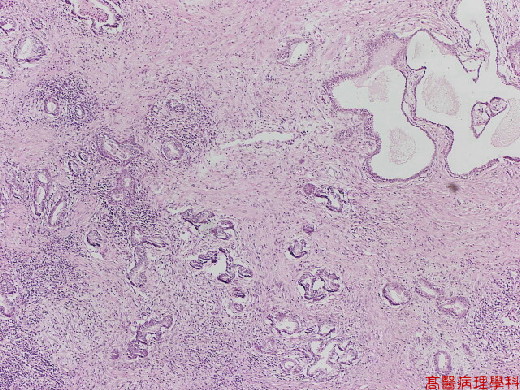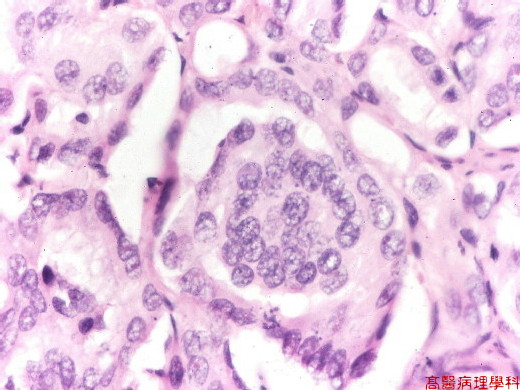¡mSlide 73.¡nAdenocarcinoma, Prostate
A. Brief Descriptions¡G
-
Carcinoma of the prostate is the most common form of cancer among men in the US.
-
Tends to occur in peripheral parts of the gland but also may occur in the transition zone.
B. Gross Findings¡G
-
Gray or yellowish, poorly delineated, firm areas.
-
Carcinoma invades the seminal vesicles and may extend into other pelvic organs.
C. Micro Findings¡G
-
Irregular, closely packed glands with papillary, loosely cribriform or fused glandular tumor, raggedly infiltration.
-
Enlarged, irregular, hyperchromatic or vesicular nuclei with prominent nucleoli.
D. Others:
-
Grading base on the degree of glandular differentiation & the growth pattern of the tumor in relation to the stroma.
-
Compare with slide 12 nodular hyperplasia of prostate.
E. Reference¡G
Robbins Pathologic Basis of Disease, 6th ed. P.1029-1033.
¡@
|
|
¡i Fig. 73-1 (2X)¡jIrregular glands raggedly infiltrated in prostate tissue.
¡@
|
|
¡i Fig. 73-2 (4X)¡jHyperchromatic neoplastic glands seen in left field.
¡@
|
|
¡i Fig. 73-3 (4X)¡jNeoplastic glands in cribriform patterns.
¡@
¡@
|
|
¡i Fig. 73-4 (10X)¡jNeoplastic glands in cribriform patterns.
¡@
|
|
¡i Fig. 73-5 (10X)¡jMonotonous cells grow in this view.
¡@
|
|
¡i Fig. 73-6 (10X)¡jMonolayer-cell growth seen in this view.
¡@
¡@
¡@
|
|
¡i Fig. 73-7 (40X)¡jHyperchromatic nuclei with coarse chromatin.






